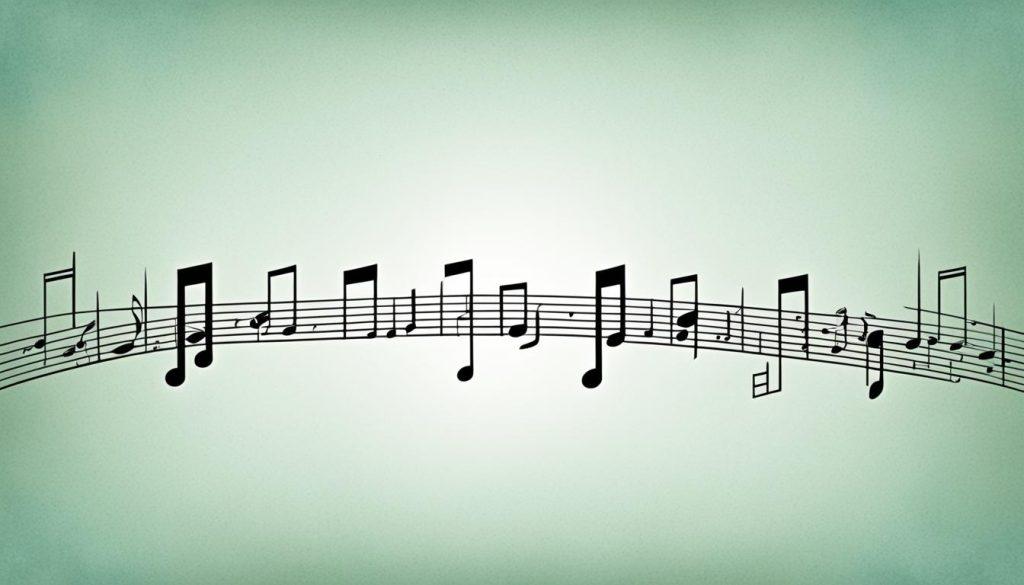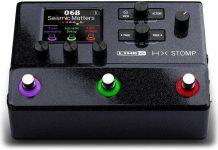This post may contain affiliate links. As an Amazon associate, Google associate as well as associate for other programs, Guitar & Music Institute may earn commissions from qualifying purchases.

Are you struggling to understand, let alone play symmetrical scales and the harmonies that are generated from them? If so, hopefully this article will go some way to explaining exactly how this at times, dark corner of music works.
This article explores the concept of symmetrical harmony and how it is used in music composition. It dives into the theory behind symmetrical scales and their balanced chord structures, providing a comprehensive understanding of this unique aspect of music.
Key Takeaways:
- Symmetrical harmony plays a crucial role in creating balanced and harmonious musical compositions.
- Symmetrical scales are derived from the chromatic scale and can be divided equally into two, three, four, or six parts.
- The whole tone scale and the diminished scale are examples of symmetrical scales used in various genres of music.
- Harmonizing symmetrical scales can create interesting and captivating chord progressions.
- Understanding symmetrical harmony unlocks a world of musical possibilities and allows for creative exploration.
Understanding Symmetrical Scales
Symmetrical scales are a fascinating aspect of music theory, derived from the chromatic scale. The chromatic scale consists of twelve equally spaced notes, and it serves as the foundation for symmetrical scales used in modern atonal music.
What sets symmetrical scales apart is their division into equal parts. The chromatic scale can be divided into two, three, four, or six parts, creating unique patterns and structures. These divisions result in symmetrical scales that offer harmonically interesting possibilities for musicians.
By understanding the concept of symmetrical scales, musicians can create compositions with balanced chord structures and explore harmonies that deviate from traditional tonal expectations.
Let’s take a closer look at how symmetrical scales are derived from the chromatic scale and how they are used in atonal music.
The Chromatic Scale: The Foundation of Symmetrical Scales
The chromatic scale consists of all twelve pitches within an octave, with each note separated by a half step. It is the most symmetric scale possible, as each step is equal in size.
- C
- C# / Db
- D
- D# / Eb
- E
- F
- F# / Gb
- G
- G# / Ab
- A
- A# / Bb
- B
The symmetrical scales are created by dividing the chromatic scale into equal parts, resulting in interesting and non-traditional harmonies.
Book from Amazon Titled Diminished Guitar Scale Mastery https://amzn.to/4cuZ1Bg
Divisions of the Chromatic Scale: Building Symmetrical Scales
The divisions of the chromatic scale give rise to various symmetrical scales used in atonal music. These symmetrical scales exhibit unique characteristics and offer musicians a wide range of musical possibilities. Here are a few examples:
- Dividing the Chromatic Scale into Two: The Whole-Tone Scale
The whole-tone scale divides the chromatic scale into two equal parts, with each step spanning a whole tone. It creates a dreamy and ethereal sound, often associated with jazz and impressionistic music. - Dividing the Chromatic Scale into Three: The Diminished Scale
The diminished scale divides the chromatic scale into three equal parts, consisting of alternating whole and half steps. It is known for its tense and mysterious quality and is commonly used in jazz and classical music. - Dividing the Chromatic Scale into Four: The Bebop Scale
The bebop scale divides the chromatic scale into four equal parts, incorporating chromatic passing tones between scale degrees. It is widely used in jazz improvisation, offering smooth melodic lines and interesting harmonic possibilities. - Dividing the Chromatic Scale into Six: The Augmented Scale
The augmented scale divides the chromatic scale into six equal parts, alternating between whole and half steps. It is commonly used in jazz and fusion music for its unique and rich harmonic sound.
These are just a few examples of the symmetrical scales derived from the divisions of the chromatic scale. Each scale offers its own distinctive sound and contributes to the world of atonal music.
Understanding symmetrical scales gives musicians the freedom to explore unconventional harmonies and experiment with atonal compositions. By incorporating these scales into their musical toolkit, musicians can craft harmonically rich and intriguing pieces of music.
The Whole Tone Scale
The whole tone scale is a symmetrical scale that consists entirely of whole steps. It is commonly used in jazz and other genres to create a unique and dreamy sound. This scale is formed by dividing the octave into six equal parts, resulting in a scale with only whole steps.
The symmetrical nature of the whole tone scale gives it a distinct and otherworldly quality. Its consistent interval pattern creates a sense of harmonic balance and uniformity. This scale is often associated with composers such as Claude Debussy and Olivier Messiaen, who used it to evoke an ethereal and mysterious atmosphere in their compositions.
One of the key characteristics of the whole tone scale is its ability to smoothly transition between chords. In chord changes, the whole tone scale provides a harmonically balanced connection between different chords. As the scale consists solely of whole steps, the transitions between chords using this scale can sound seamless and fluid.
The Diminished Scale
The diminished scale is a fascinating and widely utilized symmetrical scale in the realm of music composition. It is formed by a sequence of minor 3rds, resulting in a unique and distinctive sound. This scale is renowned for its ability to generate a profound sense of harmonic tension, adding complexity and depth to musical compositions.
Composers and musicians often employ the diminished scale to introduce captivating contrasts to other scales and harmonies. Its distinct tonal qualities can inject a burst of color and intrigue, mesmerizing listeners with unexpected twists and turns.
To visualize the diminished scale, take a look at the image below:
As seen, the diminished scale follows a distinctive pattern of minor 3rds, creating a memorable and significant harmonic impact. By incorporating this scale into their compositions, musicians have the opportunity to explore a vast array of harmonic possibilities.
Chords of the Diminished Scale
The chords of the diminished scale offer a wide range of harmonic possibilities that can elevate your musical compositions. These chords are known for their ability to create tension and resolution, adding depth and complexity to the overall sound.
One of the unique features of the diminished scale is its ability to generate altered dominant chords. Altered dominant chords are derived from the diminished scale and can provide a vibrant and colorful harmonic palette for composers to work with.
When incorporating the chords of the diminished scale into your compositions, you can explore various harmonic progressions and experiment with different voicings to achieve the desired tonal quality. They can be used effectively in both melodic and harmonic contexts, allowing you to create captivating musical experiences for your listeners.
Chords of the Whole Tone Scale
In addition to the harmonically rich diminished scale, the whole tone scale offers a diverse array of chords that can be utilized in music composition. These chords present exciting opportunities for incorporating them into the tonal world of chord changes or exploring more abstract free jazz improvisation.
The chords derived from the whole tone scale provide a harmonically balanced and intriguing sound, adding depth and complexity to musical compositions. Whether you’re looking to create lush and dreamy harmonies or experiment with unconventional tonalities, the chords of the whole tone scale offer a wide range of possibilities to explore.
By incorporating these unique chords into your musical repertoire, you can create captivating compositions that push the boundaries of traditional tonality. Whether you’re composing for a jazz ensemble or experimenting with avant-garde sounds, the chords of the whole tone scale open up a tonal world of creativity and expression.
Take a look at the image below to see the visual representation of the whole tone scale:
With the whole tone scale as your musical palette, you can dive into abstract free jazz improvisation, allowing your creativity to soar and explore unconventional harmonic possibilities. The unique chord voicings and progressions derived from the whole tone scale can bring a fresh and avant-garde flavor to your compositions.
Whether you’re seeking to captivate audiences with experimental sounds or simply looking to expand your musical horizons, the chords of the whole tone scale offer a world of tonal exploration and artistic expression.
The Magic of Symmetry
Symmetry in music is a powerful tool that can lead to the creation of harmonious melodies and chord progressions. By incorporating symmetrical scales into your compositions, such as the sixth diminished scale and the bebop scale, you can explore a world of unique sounds and textures that can only be achieved through symmetry.
When it comes to creating harmonious melodies, symmetry provides a sense of balance and coherence. The symmetrical nature of scales like the sixth diminished scale and the bebop scale ensures that no single note dominates the composition, resulting in a harmonically rich and pleasing sound.
Imagine a symmetrical piece of artwork, where every element has a reflection or counterpart. In music, symmetrical scales mirror this concept, allowing for a balanced and pleasing arrangement of notes.
The sixth diminished scale, also known as the whole-half diminished scale, consists of alternating whole steps and half steps. This scale creates a sense of tension and release, making it ideal for building dramatic melodies and exploring harmonic possibilities.
The bebop scale, on the other hand, incorporates an added chromatic passing tone, which adds a unique flavor to melodic lines. This scale is commonly used in jazz music and can create a smooth and captivating sound.
Using symmetrical scales like the sixth diminished scale and the bebop scale in your compositions can open up a world of musical exploration. These scales provide a framework for creating harmonious melodies and chord progressions that capture the listener’s attention and evoke emotions.
Incorporating symmetry into your musical compositions not only enhances the overall sound but also adds depth and complexity. Through the careful use of symmetrical scales, you can create surprising and unexpected harmonic progressions that keep the listener engaged.
Think of symmetrical scales as the building blocks of harmonious melodies. By incorporating them into your compositions, you can create a strong foundation for your musical ideas.

By harnessing the magic of symmetry, you can elevate your compositions to new heights. Whether you’re exploring the intricate nuances of the sixth diminished scale or incorporating the captivating sounds of the bebop scale, symmetry unlocks a world of harmonious possibilities.
- Create captivating and balanced melodies using symmetrical scales.
- Experiment with the sixth diminished scale and the bebop scale to add unique textures to your compositions.
- Incorporate unexpected harmonic progressions by harnessing the power of symmetry.
Embrace the magic of symmetry in your musical journey and let it guide you towards creating harmonious and captivating melodies.
Exploring Barry Harris Harmony Hacks
Barry Harris, a renowned jazz pianist, has developed a unique approach to harmony that has transformed the way musicians approach jazz piano playing. His method revolves around using specific 8-note scales to build chords and melodies, unlocking a new world of creativity and expression.
By incorporating Barry Harris harmony hacks into your jazz piano practice, you can discover fresh and exciting chord voicings that add depth and complexity to your playing. These harmony hacks provide a unique perspective on chord construction, enabling you to explore innovative ways of voicing chords that go beyond traditional jazz piano techniques.
Barry Harris encourages musicians to experiment with different chord voicings, allowing you to find your unique voice on the instrument. By utilizing his harmony hacks, you can create rich and harmonically interesting chord progressions that captivate audiences and elevate your jazz piano playing to new heights.
Benefits of Barry Harris Harmony Hacks:
- Enhanced Chord Voicings: By incorporating Barry Harris harmony hacks, you gain access to a wide range of voicings that can add sophistication and depth to your chord progressions. These voicings go beyond basic triads and seventh chords, allowing you to create lush and complex harmonies.
- Improved Jazz Piano Skills: Barry Harris harmony hacks provide a unique framework for developing your jazz piano skills. By understanding the underlying structure of chords and melodies, you can navigate the jazz repertoire with ease and confidence.
- Expanded Musical Vocabulary: Incorporating Barry Harris harmony hacks into your practice routine helps to expand your musical vocabulary. You’ll discover new and exciting chord voicings that can be applied to a variety of musical contexts, giving you greater versatility and creativity as a pianist.
- Increased Harmonic Awareness: Studying Barry Harris harmony unlocks a deeper understanding of how chords and scales relate to each other. You’ll develop a heightened sense of harmonic awareness, enabling you to make informed musical choices and create more interesting and engaging compositions.
Barry Harris harmony hacks are a valuable resource for jazz pianists looking to take their playing to the next level. By incorporating his unique approach to harmony into your practice routine, you can unlock a world of possibilities and open the door to a more expressive and captivating jazz piano playing style.
The Sixth Diminished Scale
The sixth diminished scale, also known as the major bebop scale, is a versatile scale that combines major and diminished elements. It offers a wealth of harmonic possibilities and can be used effectively over any major chord. Understanding and utilizing the sixth diminished scale can add depth and richness to jazz improvisation and composition.
One of the distinctive features of the sixth diminished scale is its ability to create harmonic tension and resolution. By incorporating both major and diminished intervals, this scale adds a unique flavor to musical phrases. It is particularly effective when used over major chords, as it introduces unexpected harmonic twists.
The sixth diminished scale consists of a repeating pattern of whole steps and half steps, creating a symmetrical structure. This symmetry allows for smooth melodic lines and allows the scale to be transposed easily to different keys. Musicians can use this scale to create intricate and compelling solos that explore a wide range of harmonic possibilities.

Harmonic Possibilities
The harmonic possibilities offered by the sixth diminished scale are vast and exciting. This scale can be used to enrich chord progressions, adding color and complexity to compositions. By harmonizing the scale, musicians can create unique chord voicings that are both harmonically interesting and melodically pleasing.
- The sixth diminished scale can be used to substitute traditional dominant chords, adding a fresh harmonic dimension to progressions.
- It can be utilized in chord substitutions, opening up new harmonic possibilities and creating unexpected tonal shifts.
- The major bebop scale, a variant of the sixth diminished scale, is frequently used in jazz improvisation. It adds a sense of fluidity and bebop flair to solos.
Experimenting with the sixth diminished scale can lead to exciting musical discoveries. Whether used as a harmonic foundation or for improvisation, this scale offers a wealth of creative possibilities for musicians of all genres.
Exploring Harmonies in the Sixth Diminished Scale
Harmonizing the sixth diminished scale is an exciting way to create captivating chord sequences. By playing the scale in thirds, you can unlock harmonically interesting patterns that add depth and complexity to your compositions. This technique allows you to explore a world of unique harmonies within the sixth diminished scale, opening up endless possibilities for musical expression.
Finding Harmonies in Thirds
When harmonizing the sixth diminished scale, start by playing each note in the scale in thirds. This means that you’ll skip a note in between each interval. By following this pattern, you’ll create a series of chords that complement the scale’s tonality.
For example, if we take the C sixth diminished scale, playing it in thirds would result in the following chord sequence:
- C diminished
- E flat diminished
- F# diminished
- A diminished
- C# diminished
- E diminished
- F diminished
- G# diminished
This chord sequence, derived from harmonizing the C sixth diminished scale, showcases the unique and captivating harmonies that can be created through this technique. Experimenting with the order and voicings of these chords can help you achieve the desired sound and emotion in your compositions.
Creating Chord Progressions
Once you have explored harmonizing the sixth diminished scale in thirds, you can use these chords to construct interesting and harmonically rich progressions. By selecting chords from the harmonized scale, you can create sequences that flow seamlessly and provide a sense of musical cohesion.
For instance, you could use the chord sequence mentioned earlier to form a progression like this:
- C diminished
- F diminished
- E flat diminished
- G# diminished
By combining these chords in different orders and exploring various rhythmic patterns, you can create captivating and sophisticated chord progressions that harmonically support your melodies.
Experimentation is key when exploring harmonies in the sixth diminished scale. Don’t be afraid to try different chord voicings, inversions, and variations to add your unique touch to the music. The more you experiment and familiarize yourself with harmonizing the sixth diminished scale, the more confidently you can incorporate it into your compositions to create harmonically intriguing and captivating pieces.
Dominant Chords in the Sixth Diminished Scale
The harmonized sixth diminished scale offers a wealth of musical possibilities, especially when it comes to dominant chords. These chords play a vital role in creating harmonic tension and interest in compositions, allowing for smooth transitions between different keys. Understanding how to find and utilize dominant chords within the sixth diminished scale empowers musicians to add depth and complexity to their music.
By incorporating dominant chords from the sixth diminished scale, you can effectively create harmonic tension and resolution. These chords serve as a bridge between keys, allowing you to seamlessly change from one key to another. Whether it’s a transitional moment or a key change, the presence of dominant chords adds excitement and unpredictability to your compositions.
Harmonic tension, created through the use of dominant chords, adds a sense of anticipation and dynamism to your music. This tension evokes a desire for resolution, pulling listeners in and keeping them engaged. The inclusion of dominant chords within the sixth diminished scale presents an excellent opportunity for you to explore harmonic tension and its emotional impact.
When working with the sixth diminished scale, experiment with different ways of incorporating dominant chords into your compositions. Whether you choose to use them as standalone chords or as part of chord progressions, their inclusion will elevate your music to new heights. They provide a rich and vibrant harmonic landscape that adds complexity and intrigue.
Remember, the ability to change keys seamlessly is a valuable skill for any musician. By understanding how to leverage dominant chords within the sixth diminished scale, you can create captivating musical journeys that keep listeners engaged and intrigued. Use the harmonic tension and interest provided by dominant chords to unlock the full potential of your compositions.
Key takeaways:
- The harmonized sixth diminished scale contains numerous dominant chords that can be utilized in compositions.
- Dominant chords enable smooth transitions from one key to another, adding depth and complexity to your music.
- Harmonic tension, created by dominant chords, generates anticipation and engages listeners in your compositions.
- Experiment with incorporating dominant chords in various ways to find unique and captivating sounds for your music.
Conclusion
In conclusion, understanding and utilizing symmetrical harmony and scales like the sixth diminished scale can unlock a world of musical possibilities. By harmonizing scales, exploring chord voicings, and embracing musical exploration, you can create harmonically balanced and intriguing compositions.
Harmonizing scales allows you to create a sense of depth and complexity in your music by combining different notes and chords that complement each other. By understanding the relationship between notes and how they interact within a scale, you can create harmonies that evoke various emotions and captivate your audience.
Furthermore, exploring chord voicings adds richness and texture to your compositions. By experimenting with different ways to play chords on your instrument, you can find unique voicings that convey the desired mood and atmosphere. This exploration of chord voicings opens doors to new sonic possibilities and allows you to create your own signature sound.
Musical exploration is at the heart of innovation and creativity. By stepping out of your comfort zone and trying new techniques, genres, or styles, you can continuously evolve as a musician. Embrace the spirit of adventure and curiosity in your musical journey, and let it lead you to new discoveries and musical heights.
FAQ
What are symmetrical scales and how are they used in music composition?
Symmetrical scales are derived from the chromatic scale and can be divided equally into two, three, four, or six parts. They are used in modern atonal music to create harmonically interesting and balanced compositions.
What is the whole tone scale and how is it used in chord changes?
The whole tone scale is a symmetrical scale consisting entirely of whole steps. It is commonly used in jazz and other genres to create a dreamy sound and can be effectively used in chord transitions, providing a smooth and harmonically balanced progression.
What is the diminished scale and how does it add complexity to musical compositions?
The diminished scale is another symmetrical scale used in music composition. It consists of a series of minor 3rds and creates a sense of harmonic tension. It is often used to add complexity and color to compositions, providing a contrast to other scales and harmonies.
What harmonic possibilities do the chords of the diminished scale offer?
The chords of the diminished scale offer a range of harmonic possibilities. They can be used to create tension and resolution in compositions, adding depth and complexity to the overall sound. Altered dominant chords can also be derived from the diminished scale, providing a unique and colorful harmonic palette.
What chords can be derived from the whole tone scale and how can they be used in music composition?
The whole tone scale offers a variety of chords that can be used in music composition. These chords can be incorporated into chord changes or used in abstract free jazz improvisation, providing a harmonically balanced and intriguing sound.
How does symmetry play a role in creating harmonious melodies and chord progressions?
Symmetry, such as that found in symmetrical scales like the sixth diminished scale and the bebop scale, plays a crucial role in creating harmonious melodies and chord progressions. By using symmetrical scales, musicians can explore unique sounds and textures that can be created through symmetry, adding a sense of coherence to their compositions.
What are Barry Harris harmony hacks and how can they be used in jazz piano?
Barry Harris is a renowned jazz pianist known for his unique approach to harmony. His method involves using specific 8-note scales to build chords and melodies. By incorporating Barry Harris harmony hacks, musicians can discover new and exciting chord voicings that can elevate their jazz piano playing.
What is the sixth diminished scale and how can it be used in jazz improvisation and composition?
The sixth diminished scale, also known as the major bebop scale, combines major and diminished elements. It offers a wealth of harmonic possibilities and can be used effectively over any major chord. Understanding and utilizing the sixth diminished scale can add depth and richness to jazz improvisation and composition.
How can the sixth diminished scale be harmonized to create interesting chord sequences?
Harmonizing the sixth diminished scale involves playing it in thirds to create interesting chord sequences. By exploring the harmonies within the scale, musicians can discover unique and captivating sounds. Playing the scale in thirds and harmonizing it as chords can create a sense of simplicity and sophistication in compositions.
How can dominant chords in the sixth diminished scale be used to change keys seamlessly?
The harmonized sixth diminished scale contains a multitude of dominant chords, which can be used to smoothly transition from one key to another. By understanding how to find dominant chords within the scale and utilizing them effectively, musicians can create harmonic tension and interest in their compositions, adding depth and complexity to their music.
Source Links
- https://www.jazzadvice.com/lessons/5-ways-to-escape-the-diatonic-trap-in-jazz-improvisation/
- https://www.freejazzlessons.com/barry-harris/
- https://mikesmasterclasses.com/course/the-magic-scale-and-symmetry/
This post may contain affiliate links. As an Amazon associate, Google associate as well as associate for other programs, Guitar & Music Institute may earn commissions from qualifying purchases.


















